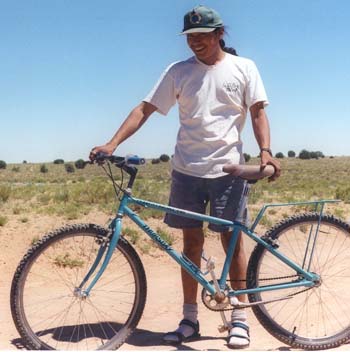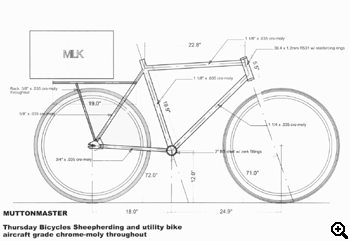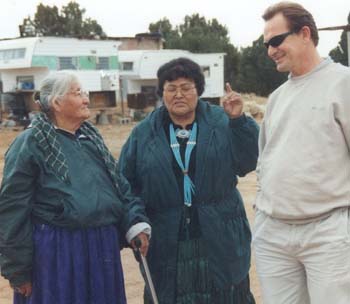[ 63XC.COM | STORIES | MUTTONMASTER ]
The Muttonmaster Story
It was the tail end of the 80s when I took a job with the Navajo Nation and moved to Window Rock. I thought I might stay a year or two and then move on, California, Oregon, or some place like that with good food and live music every night. It didn't work out that way. Maybe I'll write a book about it sometime. I have always ridden bicycles, then I started doing frame repairs, then frame modifications. After I got a set of torches, I started chopping up old frames and making new bikes, or modifying frames. My family and I lived in a ratted out, two-bedroom duplex in Tribal Housing. I bought a metal storage shed for the bicycle stuff and the other stuff that wouldn't fit in the house and didn't belong there anyway, then built some workbenches and set them up in the backyard. Window Rock is in Arizona, but it's at 7,000 feet elevation. You can work outside ten months of the year. It's usually pleasant, the light is good and paint and welding fumes just blow away. Thursday was my day to work on bicycles, especially in the long summer evenings. I laughed and started calling my shop Thursday Bicycles. I had friends and I had bikes. Well, my friends wanted bikes, and they wanted bikes that could be ridden on bad roads or over grass and desert, with racks or with safe seats for their kids. The bikes didn't have to be very fast but they had to be rugged. So I would put together bikes from stuff they had lying around, or stuff from Goodwill in Albuquerque, or stuff I found in the wash. I would change the gearing and put on the fattest, heaviest tires I could find. I started calling the bikes "Muttonmasters" because everyone joked about using them herding sheep. And so I started building the bikes more and more with sheepherding, and reservation life, in mind. I would use the seatstays from old bicycles to make racks, or sometimes old oven racks, or mystery metal from the dump. The racks were big and long so you could bolt a plastic milk crate onto them. The racks were brazed or welded on depending on how I felt--one less thing to come loose. Later, when I got hooked up with Aircraft Spruce, I started using 3/8" or 7/16" x .035 chrome moly to make racks that would hold a full-grown sheep or heavy car and truck parts. The early Muttonmasters included bikes with three-piece, English-style cranks and one-piece, American style. I got to liking the American style, which I would lube with this nasty, sticky disk brake hub bearing grease, then loc-tite down. The idea was the bottom bracket would never get any attention for the life of the bike, so I did what I could to make it last. Later on, I tried putting grease fittings on the bottom brackets. It worked, so it became a standard feature. I don't know if the fittings ever got used on most of the bikes, but they were there. I would usually try to find wide 26-inch rims, and lace them up to the nicest hubs I could find, preferably with stainless spokes. I like wheels, maybe it's some kind of breast fixation, who knows? And the alloy rims are stronger than steel, especially the cheap steel rims you find on department-store bikes. I built Muttonmasters with single speed hubs, coaster brake hubs, with 3-speed hubs, one or two with derailleurs front and rear, even one with a 7-speed Nexus hub. Multi-speed bikes are nice, but they break and then they just lean against a house or hogan wall and rust. At a certain point, it started making more sense to build the frames from scratch. The fact is that most bicycles are pretty junky, and the good ones are too lightly built for the kind of use the Muttonmasters were made for. Plus the geometry was all wrong on most of them... I started buying chrome-moly steel from Aircraft Spruce, and found that the steel in a frameset came out to $20-25. It really is a lot nicer when you can work with fresh materials. Furthermore, making my own stays allowed me to stretch the rear end, to 17 1/2 or 18 inches from the crank center to the rear axle center. The reason, of course was balance when carrying a heavy load. I kept the front frame triangles fairly long so the rider could move forward while pedaling, again for balance carrying a load. I fooled around with head and seat tube angles, but decided to stick more or less with mountain bike geometry --71/73, sometimes 72/72 depending on the rider. It did seem a good idea to raise the bottom bracket height, and the Muttonmasters all had 12" or more BB height, center to ground. Getting the 2" bottom bracket shells was a problem at first. Fortunately, Diamondback's BMX bikes were really bad those years and I had access to an unlimited supply of ruined frames. I cut the BB shells out and recycled them--they were chrome! Later, I got hooked up with SE Racing, a famous, old-school BMX bike builder in southern California. Mike at SE sold me all the chrome-moly 2-inch BB shells I could ever use. They were gorgeous. When SE went down the tubes, I bought all he had and still have a couple big boxes of them. The grease fittings on the bottom bracket also evolved. The idea was to drill a hole through the bottom bracket shell and bearing cup on each side of the seat tube, and put in an automotive-style grease fitting. I tried screw-threded zerk fittings from Pep Boyz, but they tended to come loose. I tried press-in zerks but they came loose too. In the end i just sliver-brazed them in place. When I got hooked up with J&B Importers for components, I quit using recycled bearings and cups, and got in a bunch of YST bearing sets. The cups are hard as a rock and completely resist drilling. I had to spot-anneal the cups with my torch and a 0-size tip, just enough so they could be drilled. The holes in the bearing cups, of course, had to line up with the holes in the BB shell. All this torching and drilling was on the top of the bearing cup, a place where bearing loads are minimal. You wouldn't want to do that on the bottom of the bearing. With the automotive zerk fittings, it is possible to completely fill the bottom bracket with grease in no time at all. About the time I started using aircraft grade tubing, I met an old gunsmith in Albuquerque who had worked in the California aircraft plants for a while after his WW II Marine Corps service. In those days, a lot of aircraft subassemblies, like the frames that mount engines or carry the landing gear, were welded up from chrome-moly tubing. The process used was oxy-acetylene welding. Mr. Bedeaux showed me how to do it--it involves a perfect neutral flame, good control of the weld puddle, and a good alloy for your filler rod, not the cheap stuff from Wal-Mart. I started using this process for the frames, except I continued fillet brazing the heavy steel bottom bracket shells where they join to the seat and down tubes. Later, as I got better at the process, I also welded those joints. It makes a strong joint, it's easy to clean up, and it looks great, much nicer than TIG welding. Muttonmaster theory
The reasoning behind the Muttonmaster is based on Navajo household economics, the Colorado plateau ecosystem and the conditions of Native American life. Indians symbolize the wild and free life to most people, and some scholars have proposed that 18th century Europeans' ideas of individual liberty were inspired by their encounters with Native Americans. The fact now is that Indians are the most regulated people on earth. A whole chapter of the Code of Federal Regulations (25 CFR xxx) is devoted, in minute detail, to regulating native life, land, family, education, economics and society. Grazing regulations are a fact of life for Indian people, especially Navajos. The BIA sets the number of livestock that can be grazed in a given area and apportions grazing rights through a permit system. The whole business is too deep to go into here, but what it means is that if a family is lucky enough to have a grazing permit, it will be allowed X number of 'animal units' (a mother cow and calf) or 'sheep units'. Everyone knows the math: four sheep units equals one animal unit; five sheep units equals one horse, or 1.25 animal units. The more horses you have, the fewer sheep. Although the Colorado Plateau, where the Navajo Reservation is located, is high, arid desert, it is thickly populated. Most places you are never out of sight of at least one extended family homesite, where eight or ten families might be living. Packed in like that, there isn't enough grass to go around, so people are always chipping away, running livestock on the highway right of way, running extra livestock and hoping they don't get caught, buying hay when the grass runs out or stretching the boundaries of their customary grazing use areas and risking land disputes with their neighbors. A typical extended family might have several people who do most of the sheep herding. The extended family has a customary use area, up to a several square miles, with water sources and corrals spread around. The main corral will be at the homesite, but there will be others out aways. Depending on the season, the grass will be better some places than others, so the family will move the sheep to a corral where the grass is. The sheepherder goes out at dawn, says her prayers, then goes to the corral and takes the sheep out to a water source. The water might be a mile away from the corral. After the sheep have had their drink, the sheepherder and the dogs slowly move them back to the corral, taking all day. If the sheepherder needs to go to the main house, he/she can leave the sheep with the dogs for a while and ride or walk back and forth. Toward the end of the day the sheep are back at the corral and the sheepherder closes them in with some dogs. The sheepherder can go home, or kick back at her camp, or if there are a lot of coyotes he/she might stick around with a .22. Sheepherding involves a lot of back-and-forth travel, and sheepherders mostly like to ride if they can. Horses are a fact of life, and most families have more than one. A typical setup is where a family has a really nice (and I mean really nice) roping horse, they keep it for rodeo and showing off, and maybe working livestock a little. Then they might have another horse they use for sheepherding, one that wouldn't be quite such a loss if it broke down. The Muttonmaster is meant to replace that horse. If they get rid of the horse, a family can run five more sheep on their permit. Furthermore, if they sell the horse they might make enough to pay for the bicycle, maybe even have some left over. That is the theory, anyway. There are economic reasons for things, and there are reasons of the heart, or of the natural mind. To the natural mind, a bicycle is not the same as a horse, even if it performs the same function. I didn't, couldn't make enough Muttonmasters to really change the way people use the land. Anyway some people got pretty good bicycles out of the deal and had fun riding around. And the bikes lasted pretty well. The Big Picture There is nothing in the Muttonmaster that a careful worker with a torch set and a few hand tools couldn't do in a garage, barn or blacksmith shop, or under a big tree. It takes a good deal of skill and patience, and it only makes sense if you are using good materials. The world is awash in heavy Chinese single-speed bicycles, and they can be sold anywhere in the world for less than a local macher would have to charge. But if the local macher's product is so far superior, so much more useful that there's no comparison; so strong that it could be used by three generations; so bullet- and idiot-proof that anyone can keep it running--then you have something that cannot be commoditized. And that is the economic challenge that faces craft and cottage industries all over the world.
[ TOP ] |
Writer
Thursday trades as Thursday Bikes. His slogan: Why not start the weekend on a Thursday? He still makes Mutton Masters, too.
Date
v1.0 written August 2003
Photo credits
Bike photos © Thursday.
Photo of T. with two women © Len Foster.
Related
He's probably too modest to mention it, so here's the ecstatic DirtRag review of Thursday's 26" BMX cruiser.
On this site, Thursday shares his thoughts on geometry.
Special thanks to
Tarik Saleh, who alerted us to the Mutton Master.
Mailing list
Join the 63xc.com list.


